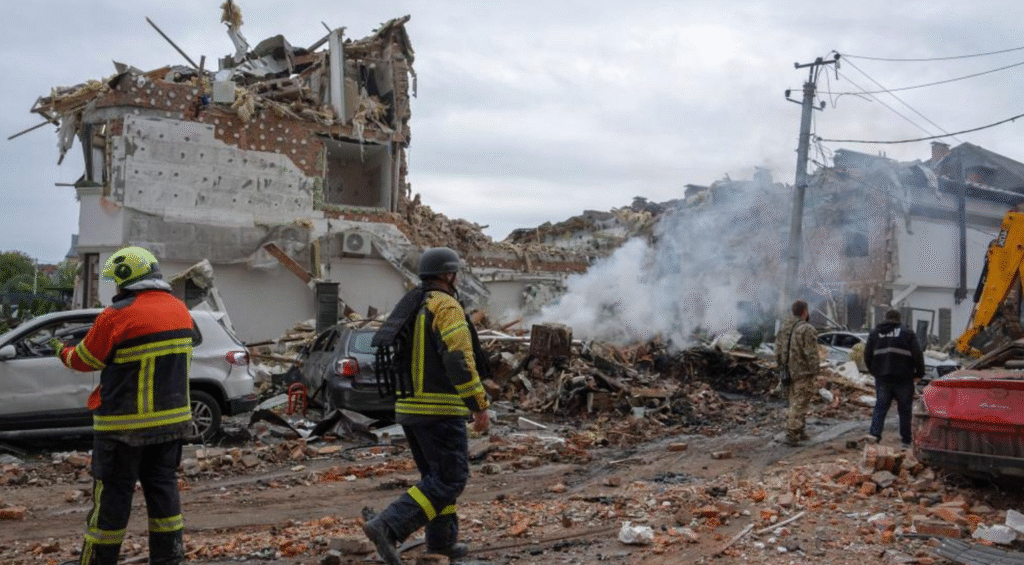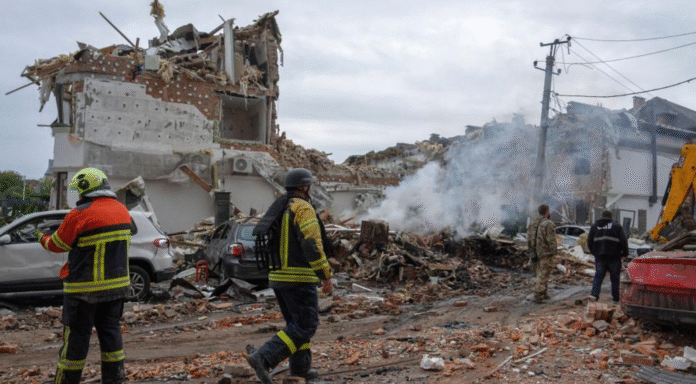Russia Attacks Ukraine: 7 Disturbing Facts From Deadly Airstrike
The war in Eastern Europe has taken yet another grim turn. In the early hours of Sunday morning, Russia attacks Ukraine with one of the largest aerial offensives since the invasion began in 2022. More than 600 drones and missiles rained down on Ukrainian cities, killing at least four civilians, including a 12-year-old girl, and injuring dozens more.
Ukrainian officials confirmed that 595 drones and 48 missiles were launched, including two ballistic missiles and several cruise missiles. This deadly strike marked the third-largest aerial assault since Russia’s full-scale invasion began nearly three years ago. Despite Ukraine’s robust defense systems, the attack demonstrated the continued vulnerability of its infrastructure and people.
Russia Attacks Ukraine With Over 600 Missiles and Drones
The Russian airstrike campaign left destruction across Kyiv, Zaporizhzhia, and other regions. According to President Volodymyr Zelensky, 42 people were injured in Kyiv, while 31 others were wounded in Zaporizhzhia.
Ukraine’s air defense managed to shoot down 43 cruise missiles and a majority of the drones. However, the sheer scale of the barrage overwhelmed even its most advanced systems. The capital’s skies filled with smoke as residents tried to continue their daily routines amidst falling debris and air raid sirens.
Why Was the Attack Significant?
This strike was not just another bombardment. Analysts believe the timing was intentional, coming right after the conclusion of the United Nations General Assembly week. President Zelensky condemned it as a clear declaration of Russia’s defiance against international diplomacy.
The Russia attacks Ukraine campaign also underlined Moscow’s intent to test Kyiv’s upgraded air defense network, which now includes Patriot missile batteries provided by Israel and Germany. These systems are among the most advanced in the world, but Sunday’s assault showed that even Patriots cannot fully shield Ukraine from sustained missile warfare.
Russia Attacks Ukraine: Impact on Civilians
The human toll is devastating. Among the victims was a 12-year-old girl in Kyiv, a stark reminder that civilians remain the primary targets of Russia’s campaign.
Eyewitness accounts paint a harrowing picture:
-
Mykhailo Yurchenko, a Kyiv resident, was seen holding his one-year-old daughter while surveying the wreckage. “Because I have a small child, it is of course very worrying. You think about her more than yourself,” he told local media.
-
Residential buildings, schools, and infrastructure were struck, forcing thousands of families into shelters.
-
Smoke and dust blanketed the skies, with explosions heard long after sunrise.
Ukraine’s presidential chief of staff, Andriy Yermak, described the assault as nothing less than a “war against civilians.”
Russia Attacks Ukraine: Poland Scrambles Fighter Jets
The aerial barrage had ripple effects beyond Ukraine. Early Sunday, Poland scrambled fighter jets in response to the incursion. Polish officials stated that while no missiles crossed into their territory this time, the risk remains high given recent drone incursions.
“These measures are preventive in nature and are aimed at securing the airspace and protecting citizens,” Poland’s army said in a statement.
The escalation raises fears of NATO involvement should Russian weapons cross into alliance territory, potentially broadening the scope of the conflict.
Russia Attacks Ukraine: A Strategic Message
Military analysts argue that this massive airstrike was less about gaining territory and more about sending a strategic message. By launching such a large-scale attack, Moscow demonstrated that it retains significant missile and drone stockpiles despite sanctions and supply challenges.
The Russia attacks Ukraine operation was also likely aimed at undermining Ukrainian morale, particularly as Kyiv continues to seek additional Western aid and military support.
International Reactions to the Russian Airstrike
Global leaders quickly condemned the strikes. Zelensky emphasized that the attack occurred just as world leaders wrapped up UN General Assembly discussions, highlighting the contradiction between diplomacy and Russia’s actions.
Western allies reaffirmed their commitment to Ukraine. Germany confirmed it would accelerate the delivery of two additional Patriot batteries. Meanwhile, the U.S. reiterated its pledge for continued military and financial assistance.
Russia Attacks Ukraine: The Psychological Impact
The assault is not only physical but also psychological. Kyiv residents are now forced to live under constant threat, never knowing when the next barrage will come. Air raid sirens have become part of daily life, and children grow up associating the sound with fear.
As one resident told reporters, “You try to act normal, walking your dog, shopping, but the fear never leaves. You always wonder if the next missile will fall near you.”

Historical Context: Russia’s Use of Mass Strikes
This is not the first time Russia has unleashed overwhelming aerial firepower. Previous barrages have targeted Ukraine’s power grid, leaving millions without electricity during harsh winters.
However, Sunday’s Russia attacks Ukraine strike was one of the largest, showcasing not just military might but also the Kremlin’s willingness to target civilians and infrastructure indiscriminately.
Conclusion
The Russia attacks Ukraine campaign of over 600 drones and missiles was one of the deadliest and most destructive airstrikes since the war began. With four dead, dozens injured, and cities in chaos, the strike highlights both Ukraine’s resilience and its vulnerabilities.
As the conflict enters another brutal phase, one thing is clear: without stronger international support and stricter consequences for Moscow, civilians will continue to pay the highest price.


